Qingqing Yang
Department of Biomedical Engineering, School of Basic Medical Sciences, Central South University, 172 Tongzipo Road, Changsha, 410013, China
BABD: A Bitcoin Address Behavior Dataset for Address Behavior Pattern Analysis
Apr 21, 2022



Abstract:Cryptocurrencies are no longer just the preferred option for cybercriminal activities on darknets, due to the increasing adoption in mainstream applications. This is partly due to the transparency associated with the underpinning ledgers, where any individual can access the record of a transaction record on the public ledger. In this paper, we build a dataset comprising Bitcoin transactions between 12 July 2019 and 26 May 2021. This dataset (hereafter referred to as BABD-13) contains 13 types of Bitcoin addresses, 5 categories of indicators with 148 features, and 544,462 labeled data. We then use our proposed dataset on common machine learning models, namely: k-nearest neighbors algorithm, decision tree, random forest, multilayer perceptron, and XGBoost. The results show that the accuracy rates of these machine learning models on our proposed dataset are between 93.24% and 96.71%. We also analyze the proposed features and their relationships from the experiments, and propose a k-hop subgraph generation algorithm to extract a k-hop subgraph from the entire Bitcoin transaction graph constructed by the directed heterogeneous multigraph starting from a specific Bitcoin address node (e.g., a known transaction associated with a criminal investigation).
Multi-scale super-resolution generation of low-resolution scanned pathological images
May 15, 2021


Abstract:Digital pathology slide is easy to store and manage, convenient to browse and transmit. However, because of the high-resolution scan for example 40 times magnification(40X) during the digitization, the file size of each whole slide image exceeds 1Gigabyte, which eventually leads to huge storage capacity and very slow network transmission. We design a strategy to scan slides with low resolution (5X) and a super-resolution method is proposed to restore the image details when in diagnosis. The method is based on a multi-scale generative adversarial network, which sequentially generate three high-resolution images such as 10X, 20X and 40X. The perceived loss, generator loss of the generated images and real images are compared on three image resolutions, and a discriminator is used to evaluate the difference of highest-resolution generated image and real image. A dataset consisting of 100,000 pathological images from 10 types of human tissues is performed for training and testing the network. The generated images have high peak-signal-to-noise-ratio (PSNR) and structural-similarity-index (SSIM). The PSNR of 10X to 40X image are 24.16, 22.27 and 20.44, and the SSIM are 0.845, 0.680 and 0.512, which are better than other super-resolution networks such as DBPN, ESPCN, RDN, EDSR and MDSR. Moreover, visual inspections show that the generated high-resolution images by our network have enough details for diagnosis, good color reproduction and close to real images, while other five networks are severely blurred, local deformation or miss important details. Moreover, no significant differences can be found on pathological diagnosis based on the generated and real images. The proposed multi-scale network can generate good high-resolution pathological images, and will provide a low-cost storage (about 15MB/image on 5X), faster image sharing method for digital pathology.
Entity Profiling in Knowledge Graphs
Feb 29, 2020



Abstract:Knowledge Graphs (KGs) are graph-structured knowledge bases storing factual information about real-world entities. Understanding the uniqueness of each entity is crucial to the analyzing, sharing, and reusing of KGs. Traditional profiling technologies encompass a vast array of methods to find distinctive features in various applications, which can help to differentiate entities in the process of human understanding of KGs. In this work, we present a novel profiling approach to identify distinctive entity features. The distinctiveness of features is carefully measured by a HAS model, which is a scalable representation learning model to produce a multi-pattern entity embedding. We fully evaluate the quality of entity profiles generated from real KGs. The results show that our approach facilitates human understanding of entities in KGs.
* 10 pages, 5 figures
 Add to Chrome
Add to Chrome Add to Firefox
Add to Firefox Add to Edge
Add to Edge